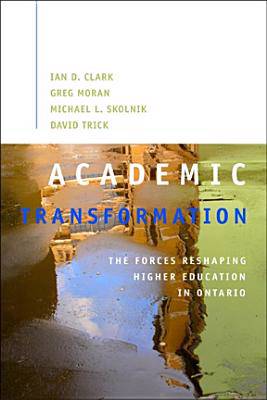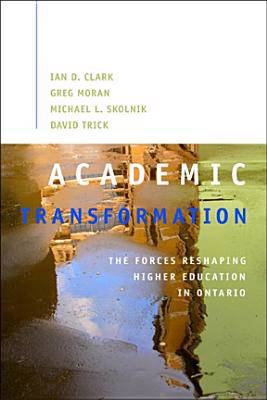
- Afhalen na 1 uur in een winkel met voorraad
- Gratis thuislevering in België vanaf € 30
- Ruim aanbod met 7 miljoen producten
- Afhalen na 1 uur in een winkel met voorraad
- Gratis thuislevering in België vanaf € 30
- Ruim aanbod met 7 miljoen producten
Zoeken
Academic Transformation
The Forces Reshaping Higher Education in Ontariovolume 138
Greg Moran, Michael Skolnik, Ian D Clark
€ 60,95
+ 121 punten
Uitvoering
Omschrijving
The large scale publicly funded system of postsecondary education in Ontario developed in the 1960s has been largely successful in fulfilling important societal needs in the areas of education, human resource development, and research. Existing approaches, however, are unlikely to be sufficient to address the challenges of the coming decade. Academic Transformation: The Forces Reshaping Higher Education in Ontario examines the developments that are re-shaping the province's post-secondary system, including higher enrollment, further development of a knowledge-based economy, increased demands for research focused on competitiveness and productivity, and Ontario's transition to a multicultural, internationally connected, urban, and aged society. Universities and colleges are also adjusting to internal changes in the composition of the student body and staff, faculty work profiles, and funding arrangements. The authors consider possible changes in the system's structure, policy, and governance that may be helpful in dealing with the anticipated changes in societal needs, and expectations related to post-secondary education.
Specificaties
Betrokkenen
- Auteur(s):
- Uitgeverij:
Inhoud
- Aantal bladzijden:
- 250
- Taal:
- Engels
- Reeks:
- Reeksnummer:
- nr. 138
Eigenschappen
- Productcode (EAN):
- 9781553392385
- Verschijningsdatum:
- 1/09/2009
- Uitvoering:
- Paperback
- Formaat:
- Trade paperback (VS)
- Afmetingen:
- 152 mm x 226 mm
- Gewicht:
- 430 g

Alleen bij Standaard Boekhandel
+ 121 punten op je klantenkaart van Standaard Boekhandel
Beoordelingen
We publiceren alleen reviews die voldoen aan de voorwaarden voor reviews. Bekijk onze voorwaarden voor reviews.











